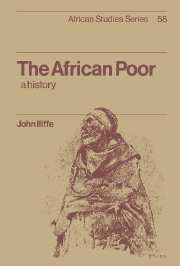Book contents
- Frontmatter
- Contents
- Preface
- 1 The comparative history of the poor
- 2 Christian Ethiopia
- 3 The Islamic tradition
- 4 Poverty and power
- 5 Poverty and pastoralism
- 6 Yoruba and Igbo
- 7 Early European initiatives
- 8 Poverty in South Africa, 1886–1948
- 9 Rural poverty in colonial Africa
- 10 Urban poverty in tropical Africa
- 11 The care of the poor in colonial Africa
- 12 Leprosy
- 13 The growth of poverty in independent Africa
- 14 The transformation of poverty in southern Africa
- Notes
- Bibliography
- Index
8 - Poverty in South Africa, 1886–1948
Published online by Cambridge University Press: 31 October 2009
- Frontmatter
- Contents
- Preface
- 1 The comparative history of the poor
- 2 Christian Ethiopia
- 3 The Islamic tradition
- 4 Poverty and power
- 5 Poverty and pastoralism
- 6 Yoruba and Igbo
- 7 Early European initiatives
- 8 Poverty in South Africa, 1886–1948
- 9 Rural poverty in colonial Africa
- 10 Urban poverty in tropical Africa
- 11 The care of the poor in colonial Africa
- 12 Leprosy
- 13 The growth of poverty in independent Africa
- 14 The transformation of poverty in southern Africa
- Notes
- Bibliography
- Index
Summary
Pre-colonial Africa was a land-rich continent. Its very poor were chiefly the incapacitated. During the late nineteenth and twentieth centuries, however, the very poor also came to include numbers impoverished by competition for resources. This took place most quickly in South Africa, where inequality was greatest and economic change most rapid. Deprivation of resources was not entirely new there, for many Khoi lacked property even in the eighteenth century and Cape Town in the 1830s already knew the family poverty of the ill-paid or jobless proletarian. Nor was the process fully worked out even in South Africa, for in the mid twentieth century those who lacked property but were able-bodied could usually escape extreme poverty by working for others, except during temporary crises of unemployment, so that the worst poverty of propertylessness was still conjunctural. Nevertheless, between the discovery of gold on the Witwatersrand in 1886 and the National Party's electoral victory of 1948 a new pattern of deprivation was added to the old.
Two other changes accompanied this transition. One was the gradual identification of the poor with the black and Coloured. This had not been the case in Cape Town or Robben Island during the nineteenth century, but by the mid twentieth century few whites were very poor. One reason for this was action by the state, whose ever greater control of property relations and poor relief was the other theme of the period.
- Type
- Chapter
- Information
- The African PoorA History, pp. 114 - 142Publisher: Cambridge University PressPrint publication year: 1987



